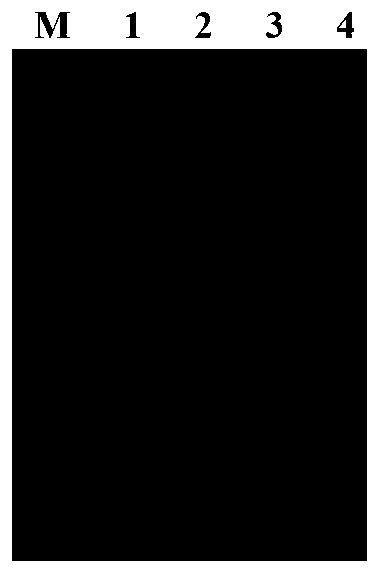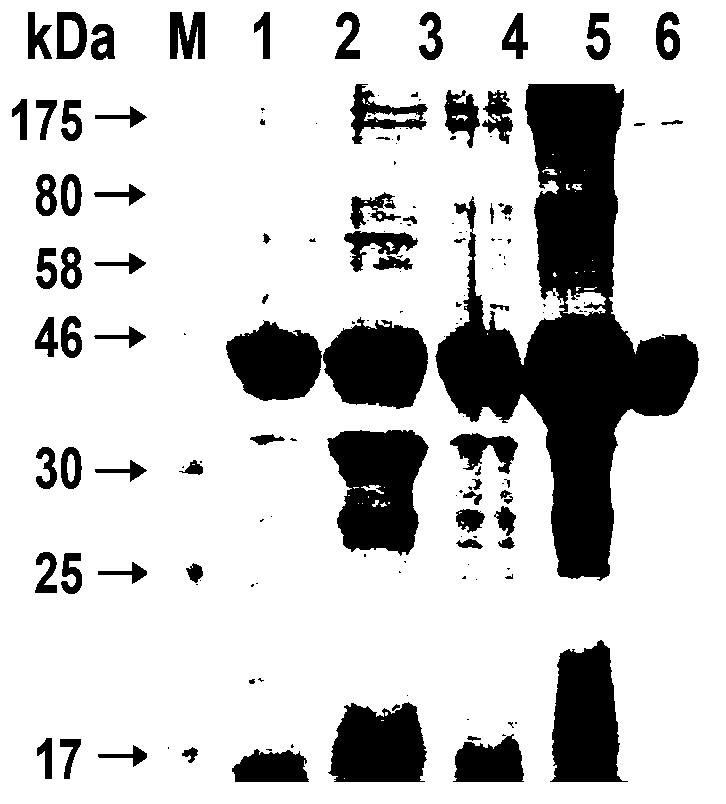Glucosyltransferase and application thereof
A technology of glycosyltransferase and glucosyl, which is applied in the field of new glucosyltransferase, can solve the problems of unreported research on modification steps, and achieve the effects of improving bioavailability, enhancing drug efficacy, and improving water solubility
- Summary
- Abstract
- Description
- Claims
- Application Information
AI Technical Summary
Problems solved by technology
Method used
Image
Examples
Embodiment 1
[0039] Example 1 Cloning of Glucosyltransferase Gene
[0040] 1. Genomic DNA extraction
[0041] Marine Bacillus B-9987 was inoculated in 10 mL of LB liquid medium, cultured overnight at 37°C, collected by centrifugation, and the supernatant was discarded; washed twice with 1 mL of STE buffer; added 500 μL of STE buffer prepared 3-5 mg / mL lysozyme solution, carefully suspend the bacteria, and bathe in 37°C water for 30 minutes until the cells become translucent; add 250 μL of 3% SDS, mix gently up and down, continue to bathe in 37°C water until clarified; add After adding 1 / 10 volume of 3 M NaAc (pH=4.8), add 200 μL of phenol: chloroform: isoamyl alcohol (25: 24: 1 ), invert the centrifuge tube several times, and centrifuge at 12,000 rpm for 10 min; pipette carefully Take the supernatant, extract repeatedly with phenol: chloroform: isoamyl alcohol, until the middle layer is free of protein impurities, transfer the supernatant, add an equal volume of isopropanol (or 2 times th...
Embodiment 2
[0047] Example 2: In vitro enzyme activity detection of MlnGT1 protein
[0048] In vitro enzyme activity reaction system: (100 μl )
[0049] 2.5M Tris-HCl buffer (pH7.5): 1 μl
[0050] 0.1mM MgCl 2 : 1 μ1
[0051] 15 mM Macrolactin A: 2 μl
[0052] 20 mM UDP-Glu: 5 μl
[0053] 0.2 mM MlnGT1 protein: 5 μl
[0054] wxya 2 O: 86μ1
[0055] Reaction conditions: 37°C, 30min. After the reaction, add 100 μl of methanol to stop the reaction, centrifuge at 13,000rpm for 20 minutes, discard the precipitate, and remove the protein in the reaction solution. The resulting supernatant was subjected to HPLC detection.
[0056] HPLC detection: use reversed phase C18 column (specification: 150 × 4.6 mm, 5μ); column temperature is 30°C; elution condition: 0-5 min equilibration: 65% phase A (ddH 2 O+0.1% formic acid) and 35% phase B (acetonitrile+0.1% formic acid); 5-20 min linear elution, 35-0% A phase and 35-100% B phase; 20-30 min isocratic elution: Phase A: 0%, Phase B: 100%; detec...
Embodiment 3
[0059]Example 3: Transglycosylation of macrolides by MlnGT1 glycosyltransferase
[0060] When TDP-Glc was used as the glycosyl donor, UDP-Glu in the enzyme reaction system in Example 2 was replaced by TDP-Glu, incubated at 37°C for 30min, and after the reaction was terminated, HPLC detection and HRMS analysis were performed, and the results were the same Obtain glycosylated Macrolactin A ( Figure 4 B). Thus it is proved that the glycosyltransferase of the present invention has a good application prospect.
[0061]
[0062]
[0063]
[0064]
PUM
 Login to View More
Login to View More Abstract
Description
Claims
Application Information
 Login to View More
Login to View More - Generate Ideas
- Intellectual Property
- Life Sciences
- Materials
- Tech Scout
- Unparalleled Data Quality
- Higher Quality Content
- 60% Fewer Hallucinations
Browse by: Latest US Patents, China's latest patents, Technical Efficacy Thesaurus, Application Domain, Technology Topic, Popular Technical Reports.
© 2025 PatSnap. All rights reserved.Legal|Privacy policy|Modern Slavery Act Transparency Statement|Sitemap|About US| Contact US: help@patsnap.com



